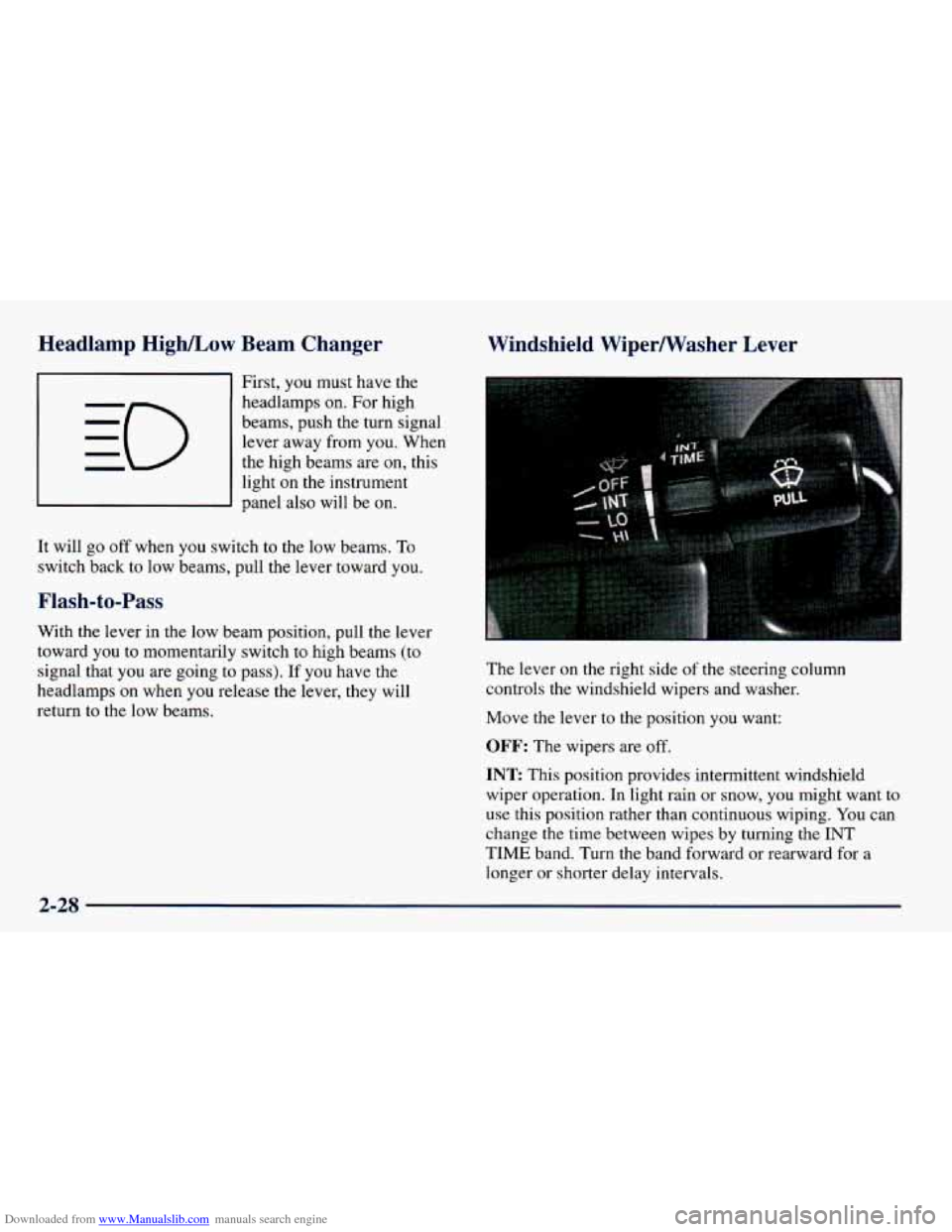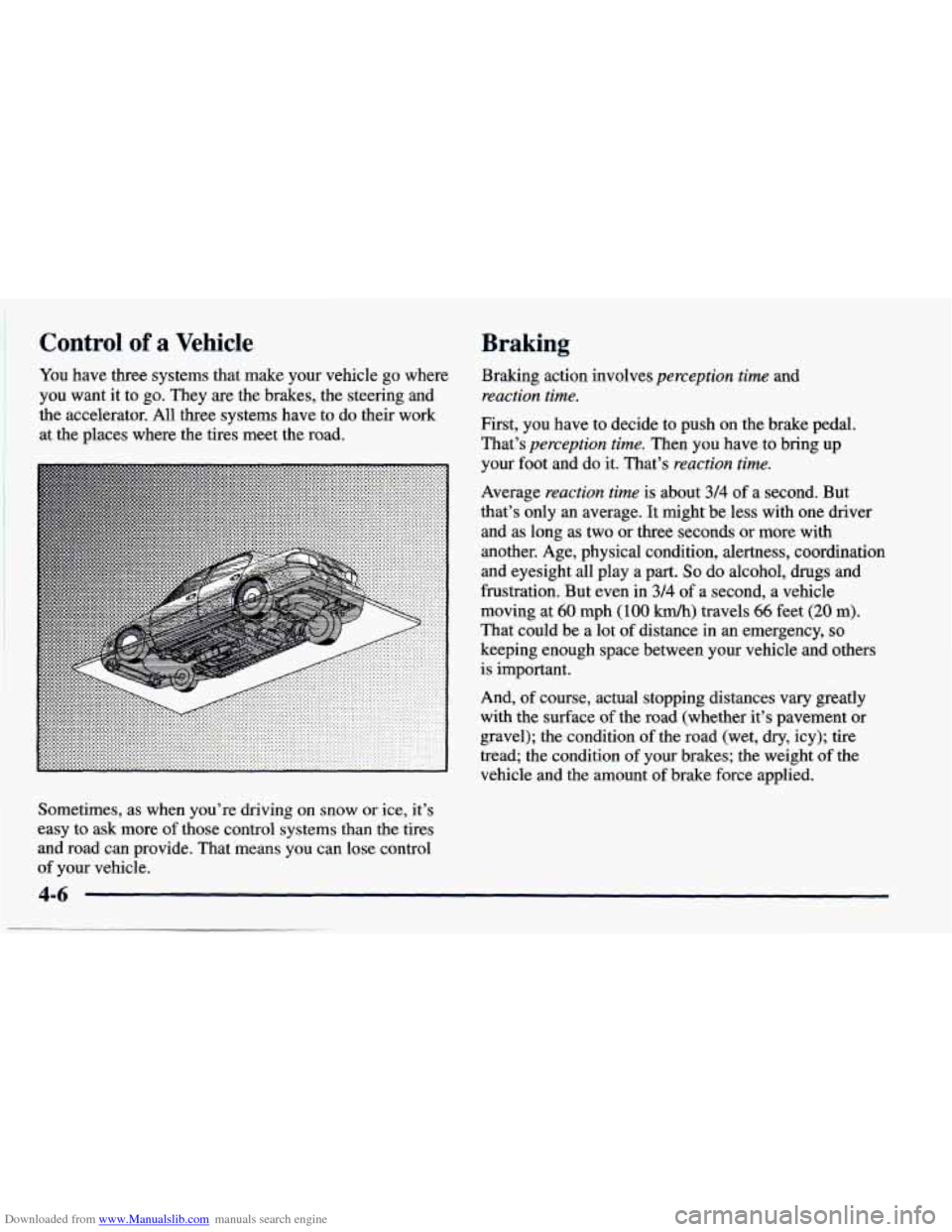Page 104 of 364
Downloaded from www.Manualslib.com manuals search engine You can also open this window any amount by pushing
the switch halfway down and releasing it when you want
the window
to stop.
Do not push the switch when the window is in the
express-down mode.
There are individual controls near each window. Push
down the front of the switch to lower a window and lift
the front of the switch to raise a window.
Lock-Out Switch
Press the window lock switch to keep passengers from
using their individual window switches. Press the switch
again to unlock the windows.
Horn
To sound the horn, press anywhere on the horn pad on
your steering wheel.
Tilt Column (Option)
A tilt steering column allows you to adjust the steering
column before you drive.
To tilt the column, pull down on the lever. Move the
steering wheel to a comfortable level, then move the
lever upward
to lock the column in place.
2-26
Page 105 of 364

Downloaded from www.Manualslib.com manuals search engine Turn SignaUMultifunction Lever
The lever on the left side
of the steering column
includes your:
0 Turn Signal and Lane Change Indicator
0 Headlamp High/Low Beam Changer
Flash-to-Pass
Turn Signal and Lane Change Indicator
The turn signal has two upward (for right) and two
downward (for left) positions. These positions allow
you to signal a turn or a lane change.
To signal a turn, move the lever all the way up or
down. When the turn is finished, the lever will
return automatically. An
arrow on the instrument
panel will flash in the
direction
of the turn or
lane change.
To signal a lane change, just raise
or lower the lever
until the arrow starts to flash. Hold it there until you
complete your lane change. The lever will return by
itself when you release it.
If you signal a turn or a lane change, and notice the
arrow flashing rapidly, a signal bulb may be burned out
and other drivers won’t
see your turn signal.
If a bulb is burned out, have it replaced to help avoid an
accident.
If the arrows don’t go on at all when you
signal a turn, check for burned-out bulbs and then check
the fuse
(see “Fuses and Circuit Breakers” in the Index).
2-27
Page 106 of 364

Downloaded from www.Manualslib.com manuals search engine Headlamp HighlLow Beam Changer
First, you must have the
headlamps on. For high
beams, push the turn signal
lever away from
you. When
the high beams are on, this
light on the instrument
panel also will be
on.
It will go off when you switch to the low beams. To
switch back to low beams, pull the lever toward you.
Flash-to-Pass
With the lever in the low beam position, pull the lever
toward you to momentarily switch to high beams (to
signal that you are going to pass). If you have the
headlamps on when you release the lever, they will
return
to the low beams.
Windshield Wipermasher Lever
The lever on the right side of the steering column
controls the windshield wipers and washer.
Move the lever to the position you want:
OFF: The wipers are off.
INT
This position provides intermittent windshield
wiper operation. In light rain or snow, you might want
to
use this position rather than continuous wiping. You can
change
the time between wipes by turning the INT
TIME band. Turn the band forward or rearward for a
longer or shorter delay intervals.
2-28
Page 113 of 364
Downloaded from www.Manualslib.com manuals search engine Reading Lamp (If Equipped)
If you have a sunroof, you have a reading lamp near the
sunroof switch. Press the switch to
turn the lamp on and
press it again to
turn it off.
Mirrors
Inside Daymight Rearview Mirror
An inside rearview mirror is attached to your roof. The
mirror has a pivot
so that you can adjust it up and down
or side to side.
You can adjust the mirror for day or night driving. Pull
the tab for night driving to reduce glare. Push the tab
for daytime driving.
Outside Manual Adjust Mirrors
Adjust these mirrors by rotating the lever to the left of
your steering wheel so that you can just see the side of
your vehicle when you are sitting in a comfortable
driving position.
2-35
Page 114 of 364
Downloaded from www.Manualslib.com manuals search engine Power Remote C
(If Equipped)
The remote power mirror
control is to the left of
your steering wheel.
To adjust either mirror,
move the switch to
L (left)
or R (right). Then use
the touch pad to adjust
the mirror.
Once you have adjusted both mirrors, move
the switch
back to the center. This prevents moving
the mirrors
accidentally once
you have adjusted them.
Convex Outside Mirror
Your passenger’s side mirror is convex. A convex
mirror’s surface
is curved so you can see more from
the driver’s seat.
A convex mirror can make things (like other
vehicles) look farther away than they really are.
If you cut too sharply into the right lane, you
could hit a vehicle
on your right. Check your
inside mirror or glance over your shoulder
before changing lanes.
2-36
Page 153 of 364
Downloaded from www.Manualslib.com manuals search engine 0 Section 4 Your Driving and the Road
Here you’ll find information about driving on different kinds of roads and in varying weather conditions. We’ve also
included many other useful tips
on driving.
4-2 4-3
4-6
4-6 4-
10
4-12
4-12
4-13
4- 15 Defensive Driving
Drunken Driving Control of a Vehicle
Braking Steering
Off-Road Recovery
Passing
Loss of Control
Driving
a Night Driving
in Rain and on Wet Roads
City Driving
Freeway Driving Before Leaving on a Long Trip
Highway Hypnosis
Hill and Mountain Roads
Winter Driving Loading Your Vehicle
Towing a Trailer
4- 16
4- 19
4-20
4-2
1
4-2 1
4-22
4-24
4-2 8
4-30
4-1
Page 158 of 364

Downloaded from www.Manualslib.com manuals search engine Control of a Vehicle
You have three systems that make your vehicle go where
you want it to
go. They are the brakes, the steering and
the accelerator. All three systems have to do their work
at the places where the tires meet the road.
Sometimes, as when you’re driving
on snow or ice, it’s
easy to ask more
of those control systems than the tires
and road can provide. That means
you can lose control
of your vehicle.
Braking
Braking action involves perception time and
reaction time.
First, you have to decide to push on the brake pedal.
That’s
perception time. Then you have to bring up
your foot and
do it. That’s reaction time.
Average reaction time is about 3/4 of a second. But
that’s only
an average. It might be less with one driver
and as long
as two or three seconds or more with
another. Age, physical condition, alertness, coordination
and eyesight all play a part.
So do alcohol, drugs and
frustration. But even in
3/4 of a second, a vehicle
moving at
60 mph (100 km/h) travels 66 feet (20 m).
That could be a lot of distance in an emergency,
so
keeping enough space between your vehicle and others
is important.
And, of course, actual stopping distances vary greatly
with the surface
of the road (whether it’s pavement or
gravel); the condition of the road (wet,
dry, icy); tire
tread; the condition of your brakes; the weight
of the
vehicle and the amount of brake force applied.
Page 161 of 364

Downloaded from www.Manualslib.com manuals search engine Remember: Anti-lock doesn’t change the time you need
to get your foot up to the brake pedal or always decrease
stopping distance. If you get too close to the vehicle in
front of you, you won’t have time to apply your brakes
if that vehicle suddenly slows or stops. Always leave
enough room up ahead to stop, even though you have
anti-lock brakes.
Using
Anti-Lock
Don’t pump the brakes. Just hold the brake pedal down
firmly and let anti-lock work for you. You may feel a
slight brake pedal pulsation or notice some noise, but
this is normal.
Braking in Emergencies
At some time, nearly every driver gets into a situation
that requires hard braking. If
you have anti-lock, you can steer and brake at the
same time. However, if you don’t have anti-lock, your
first reaction
-- to hit the brake pedal hard and hold it
down
-- may be the wrong thing to do. Your wheels can
stop rolling. Once they do, the vehicle can’t respond to
your steering. Momentum will carry it in whatever
direction it was headed when the wheels stopped rolling.
That could be off the road, into the
very thing you were
trying to avoid, or into traffic.
If you don’t have anti-lock, use a “squeeze” braking
technique. This will give you maximum braking while
maintaining steering control. You do this by pushing on
the brake pedal with steadily increasing pressure.
In an emergency, you will probably want to squeeze
the brakes hard without locking the wheels.
If you
hear or feel the wheels sliding, ease off the brake pedal.
This will help you retain steering control.
(If you do
have anti-lock, it’s different: see “Anti-Lock Brakes”
in the Index.)
In many emergencies, steering can help you more than
even the very best braking.
4-9